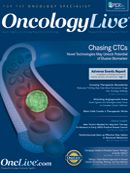Publication
Article
Oncology Live®
On the Trail of a New Type of Biopsy
Author(s):
We explore the progress and challenges that circulating tumor cell technology offers toward that goal.
OncLive Chairman,
Mike Hennessy
As our understanding of the molecular drivers of cancer becomes more refined, the need for assays that would help clinicians to more precisely diagnose and manage patients with solid tumors grows more pressing.
Thus, the hunt for the “liquid biopsy,” an emerging category of biofluid-based methods for analyzing the presence and progression of a solid tumor at the genomic level without the need for an invasive procedure. On OncLive, we explore the progress and challenges that circulating tumor cell (CTC) technology offers toward that goal.
There is no question that measuring the level of CTCs in patients with metastatic breast, colorectal, or prostate cancer helps assess the progression of disease and serves as a predictor of treatment response. The CellSearch system has been approved by the FDA for these purposes.
However, in order to make the leap to full clinical utility, the tools to analyze CTCs and other biological materials must take another step forward so that clinicians can use test results to make therapeutic recommendations.
Our story, “Chasing CTCs: Novel Technologies May Unlock Potential of Elusive Biomarker,” delves into research efforts under way to not only enumerate CTCs but also analyze these rare cells at the molecular level. Although progress is being made, there are no predictions about how quickly new methods might be available for clinical use.
It seems certain, however, that research interest in maximizing the use of CTCs to advance patient care will grow more intense. In fact, the focus will be not only on this biomarker but other “biofluids” that might prove to be a piece of the puzzle for developing a liquid biopsy.
For patients, this quest is of utmost importance. As anticancer strategies move forward, the ability to fully administer molecularly based therapies to patients with solid tumors will be hampered if clinicians have to rely on tumor tissue to make decisions.
We consider it part of our editorial mission to keep you informed of developments in this field. Please let us know what you would like to see in the pages of our publications and on our website. And, as always, thank you for reading.










